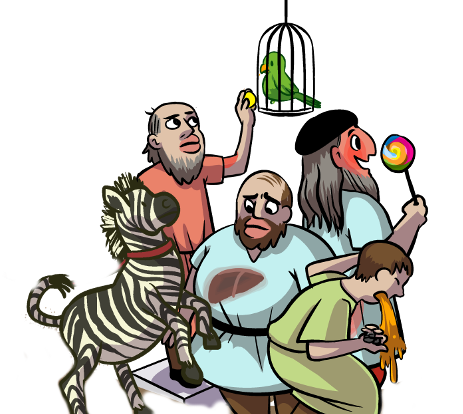Memorize Anything
Simple steps to memorize anything using your visual, spatial, and emotional memory.
Did you ever need to memorize a table of facts for some test? Tired of reading and rereading through the table hoping the information will somehow stick? This article outlines simple steps for using your imagination to build “memory scenes” that leverage your visual, spatial, and emotional memory.
Simple
Start with a unifying theme. Come up with a consistent theme for all your objects in the scene that relates to your overall topic. For example, a period in time (Renaissance) or a location (local diner). This common theme will reinforce the connections binding all your symbols together. Setting a scene also makes it easier to come up with individual symbols.
For example, if you recall that the entire scene was set in a farm field but you’re forgetting one area, you have a better chance of narrowing it down as you try to recall common farm objects likely present. If the scene had been too ridiculous and involved completely unrelated objects, then good luck. You’re screwed. It’s very easy to forget a symbol that’s unattached to anything else.
If you’re having trouble coming up with a theme, go work on a few key objects to get a feel for the elements, and then return to the overall theme and figure out how these objects will come together.
What immediately pops into your head? When you repeat the word or fact to yourself, what is the first thing that comes to mind? Run with that natural association.
Stew on it. If nothing immediately comes to mind, don’t be afraid to mull around for a while until you find something that really fits. Play with the word some. Roll it around in your mouth. Pronounce it in various ways. Look for a synonym. Use a dictionary to find other words that begin with the same first few letters. Instead of representing the word directly, represent a key fact about the concept. For example, to represent Calcium, you could use Milk or a Cow.
Trigger off most characteristic syllable. Unless every syllable is important, just use the one with most emphasis. For example, for the medication alendronate (a-len-DRONE-ate), the most characteristic syllable sounds like “drone”, and you could represent it with a robot drone.
Use easily recognizable objects. If the object is too complicated or unusually decorated, it might get blurred in your visual memory. Use dynamic action to make things memorable.
Stark contrasts. Avoid weak or qualitative differences between contrasting objects. Symbols should be either huge or tiny, incredibly strong or laughably scrawny. Contrasting objects should be near enough that the differences are obvious.
Only include salient features. Ignore details in the initial stages. As you become an expert in a topic, the details just naturally associate with the topic in your mind. There is less need to fit them in at the beginning of scene formation.
Avoid multiple associations per object. Aim for a 1-to-1 mapping between symbols and facts. You may think you’re clever with one object representing three facts, but it’s easy to forget when there’s a list.
Consistency. Aim for all your facts to be roughly the same size. If some of your objects are huge and some are tiny, your mind’s eye may be overwhelmed by the huge objects and forget all the tiny details.
Avoid clutter. Too many symbols and they’ll mush together. Spread them out. Split it up into multiple scenes, and reuse some symbols to link the scenes. Also avoid putting in unnecessary detail: don’t put anything in the scene that doesn’t actually represent a fact.
Vivid pictures
Visceral and emotional. In order to get as many brain cells firing as possible, you need to evoke visceral or emotional reactions. Gross blood, smelly fish, painful wounds, a deflated ego, a guilty conscience, an attractive person.
Dynamic scenes. Use action to get your attention. A bunch of independent, static objects can become a fragmented blur. A bunch of interactive objects and moving actors will stick.
Positioning. An object high up on a shelf might indicate a high value; conversely, an object on the ground might indicate a low value. An object falling down off a table might indicate a falling value.
Make it real to you. Walk around it to see it from all sides. Push something around. Focus on details. Smell, taste, and touch.
Getting faster
There is an up-front cost of time spent generating a scene, but I’ve found that I don’t have to restudy material which saves me time overall. Even more, as I’ve practiced constructing scenes, the process has become faster. I’m faster now at coming up with symbols, associations, and an integrated scene. Reusing symbols from previous scenes reinforces those same associations.
Spaced repetition is an efficient algorithm for scheduling when to revisit a weak topic, but it does nothing to help you when you’re actually trying to absorb the specific topic material. Sometimes I felt like I was getting hit in head with a hammer repeatedly every time I encountered the same topic day after day, each time unable to actually absorb and assimilate the details for any meaningful retention.
Spend time reviewing and interacting with your mental scenes. Close your eyes and walk through them. As you review, reach out to touch every object to make it real, as if you’re there in the scene.
